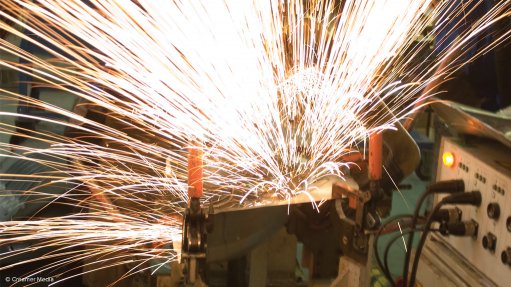
Photo by: Duane Daws
Although the seasonally adjusted Barclays Purchasing Managers’ Index (PMI) rose to 45.5 index points in December, up from a more than six-year low of 43.3 points in November, it still indicates that the local manufacturing sector is under pressure.
Speaking to Engineering News Online in a telephone interview on Thursday, Barclays economist Miyelani Maluleke stated that the lack of demand in production confidence had contributed to the PMI remaining below the neutral 50-point mark.
Despite the uptick in December, the average of 45.6 index points for the fourth quarter was 4.5 index points below the average recorded in the third quarter.
This suggested that after output staged a significant rebound in the third quarter, production growth was likely to come under renewed pressure in the fourth quarter.
Manufacturing production, as measured by Statistics South Africa, also declined by 1.7% and 1.2% (month-on-month, seasonally adjusted) in October and November respectively.
This meant that, barring a strong performance in December, which was unlikely given the sustained weakness in the PMI, the sector was likely to contract on a quarter-on-quarter basis in the fourth quarter of 2015. Amid increasing drought conditions and continued pressure on the mining sector, this did not bode well for overall gross domestic product growth.
Investec economist Kamilla Kaplan concurred, stating that a sustained expansion in production levels has been inhibited by adverse demand conditions.
“Suppressed market conditions in the agriculture, commodity and energy industries are reflected in dampened demand for manufactured goods, while weaker demand also stemmed from the consumptive sectors of the economy. Further, export orientated manufacturers have been contending with the slow rate of expansion in global new export orders,” she said.
Maluleke further pointed out that the continued slowing of China’s economy – one of South Africa’s most important trading partners – would have an adverse impact on manufacturing prospects.
In 2014, about 40% of the country’s export basket comprised Chinese trade.
Despite the weak headline figure, all the major subcomponents of the PMI increased in December, albeit slightly. Most notably, the index measuring suppliers’ performance rose back above 50 points for the first time since July 2015.
However, business activity remained weak as the index only rose by one point to 42.4 in December, likely owing to demand also remaining sluggish. The new sales orders index only increased to 44.8 index points from 43.5 in November.
Prospects for the sector remain subdued with the PMI leading indicator falling further below the one-point level in December. This meant that inventories outstripped demand, which also did not bode well for production growth going forward. Manufacturers also remain pessimistic about business conditions through the first half of this year.
The index measuring expected business conditions in six months’ time remained below 50 for a second straight month. While the significantly weaker rand exchange rate could provide local exporters with some competiveness benefits in international markets, it also pushed up costs.
As such, the PMI’s price index ticked up for a second straight month. This put pressure on selling price margins and overall profitability.
“Despite the fact that we are seeing weakness when it comes to the activity side, we are seeing an increase in input costs, which partly reflects the rand’s sustained depreciation.
“This does raise the risk that some of the business pressure would be passed on to the consumer,” Maluleke said.
Nevertheless, he pointed out that the depreciation would provide competitive support to parts of the manufacturing sector that were outward-looking and manufacturing products to substitute imports. “That’s one little bit of hope that could offset the weakness in demand,” he noted.